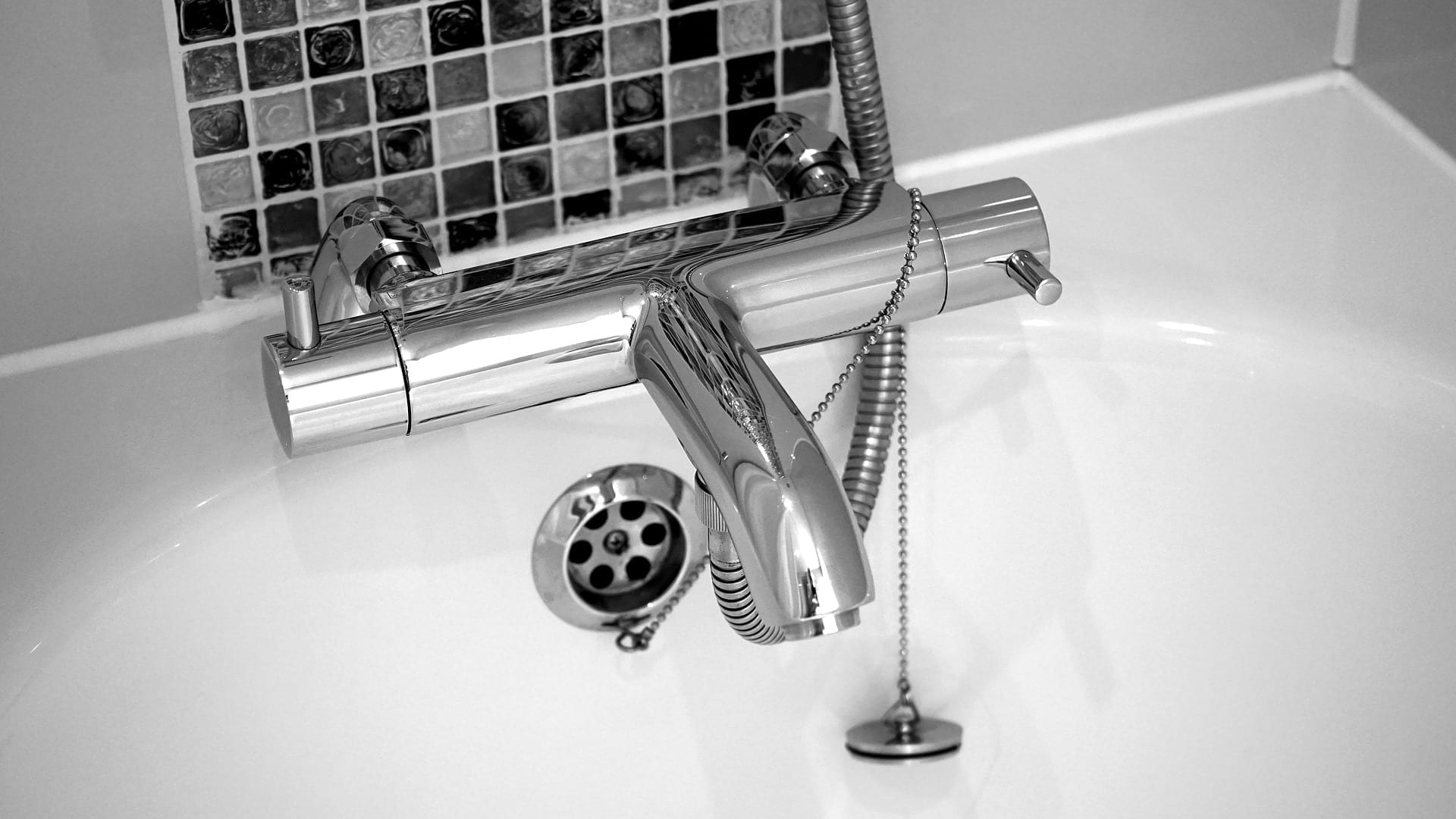
Your sink, toilet, or bathtub is clogged. Is the problem at the trap, the main line, or somewhere in between? The plumbers on our drain remediation team have the tools to quickly analyze your situation and get your drain open and flowing. Our plumbers can diagnose and solve your “drain pain” quickly and professionally.
Diagnosing an Impending Clogged Drain
The best way to handle drain clogs is to avoid them altogether through our annual plumbing inspections, during which our plumbers diagnose issues with your pipes that will lead to clogs and solve them before clogs can form. If you join our Comfort Club, we’ll contact you once a year for your pre-paid annual plumbing inspection.
Unfortunately, there are not many warning signs of impending clogs, but if you experience any of these signs, you should call in our drain remediation team right away:
- Slow Drains: If your sink, bath, or shower is draining slower than usual, it’s often the initial indicator of a plumbing issue, like a leak, debris buildup, or more.
- Odors from Drains: When your floor drain keeps backing up, it means there’s a buildup of waste. These need to be removed before there is extensive damage.
- Water Rings Near Floor Drains: Fluid backup from a floor drain might create water rings that subside slowly. If you spot these rings, even if the fluid has receded, it’s a sign of drainage trouble.
How to Open a Clogged Drain
You can treat slow drains with hot water, baking soda and vinegar, or pour salt down your drain at night, hopefully keeping clogs at bay; just never use chemical drain openers, and never pour boiling water down PVC pipes.
There are only two basic ways to open fully clogged drains: plungers and snakes. Occasionally, a homeowner can successfully open drains themselves using these tools, but it often takes a professional plumber to remove drain covers, stoppers, traps, and clean-outs in order to access the clog and remove it.
Plungers and Evacuators
For a plunger to be effective, it needs to create a tight seal with the sink, tub, or toilet. This seal is crucial for building enough suction to dislodge a clog from the pipe walls. To gauge the plunger’s success, there should be standing water. If you see the water level going down, it indicates progress.
Keep in mind that not all plungers are the same; if a dollar store plunger isn’t doing the job, consider investing in a higher-quality version from a home supply store. Professional plumbers often use high-suction evacuators, or outside drain plungers, which can be even more effective than traditional plungers.
Augers and Snakes
There are many types of augers and drain snakes. For bathroom sink and tub clogs, a flexible plastic stick with prongs to grab debris can be effective. For bigger jobs like a clogged toilet, a drain snake can be used. These devices come with hand cranks or motors and work by swirling a flexible metal cable around in your pipes until the clog breaks up.
The pipework beneath sinks, showers, and bathtubs can be very intricate, and it is possible to damage the components using augers or snakes, especially in older homes. Even toilets can be damaged by the use of drain snakes. It is best to have a professional plumber snake your drains rather than risk expensive plumbing repairs.
What Happens During a Drain Remediation Visit?
Our experts utilize various clogged drain remedies based on the clog’s location. This may involve removing a drain cover and cleaning the cap, p-trap, or sink stopper pop-up mechanism.
For less severe clogs, a high-suction evacuator or auger is used to dislodge and open the drain. Subsequently, hot water is employed to ensure smooth drainage. In the case of major drain pipes, a camera is utilized to assess system integrity.
After successfully opening the drain and restoring water flow, our experts reinstall the hardware to its original state, ensuring everything functions seamlessly.
How to Avoid a Clogged Drain
There are a variety of different drains around your house that need to be kept open so they work properly. Some are easier to maintain than others. Always make conscious decisions about what you put down your drains.
Be Cautious of What You Throw Down The Garbage Disposal
Grease, soap, and food waste can take their toll on kitchen drains, clogging them over time. Garbage disposals do not prevent clogs, and they can become clogged or jammed themselves with improper usage.
Never put grease down a drain. Even if you have a garbage disposal, use it only for tiny bits of food that cannot be gathered and thrown away in a waste can. Always have cold water running when you turn on your garbage disposer. This keeps oils hard and moving through your pipes instead of coagulating them.
Put Strainers on Shower and Tub Drains
Hair is the biggest danger with shower and tub drains, so make sure there is a shower drain strainer in your bathroom. Regularly remove the hair that builds up on the strainer. Even if you have no hair or little hair, strainers will stop small items like soap pieces, shampoo caps, or jewelry from slipping down the drain.
Don’t Flush Objects Down the Toilet
There are only two items that should be placed in a toilet: toilet paper and human waste. Clogged toilets are often the result of flushing the following:
- Facial Tissue
- Cat Litter
- Feminine Products
- Baby Wipes or ‘Flushable’ Wipes
Protect Bathroom Sink Drains
Clogs in bathroom sinks can result from toothpaste, soap, hair, styling products, and other grime. Bathroom sinks with drain stoppers do not accommodate strainers, so extra care must be taken to keep clogging substances out of these drains.
Run water the entire time you are brushing your teeth. Consider spitting into a tissue instead of the sink, and use paper towels to wipe styling products and hair from your hands before you rinse them off.
Lastly, if you feel the need to vomit, use the toilet, not the sink.
Keep Debris Out of Floor Drains
Floor drains capture soap from cleaning products and laundry detergent that can build up scale over time. They are also susceptible to receiving any kind of dirt, debris, or trash that finds its way to the floor, which can clog them up quickly. Never sweep anything into a floor drain other than water.
Get Your Sewer Drain Snaked Regularly
If water backs up in your floor drains or toilet after using large amounts of water, it probably means your sewer pipe is clogged. These are the pipes that run from your house to either the city sewer or to your septic tank.
Sewer drains are at risk of being clogged by the same items that clog your interior pipes. But an additional risk to sewer drains is plant roots that seek an easy way to water sources through your sewer pipe. Trees and bushes in your landscaping can clog sewer drains quickly, depending upon the growing season, so professional drain snaking of outside drains is recommended to keep roots from taking over.
Also, pay attention to where your sewer pipes are buried; driving over them or parking on them can cause them to collapse and require them to be replaced.
Get your septic tank inspected regularly. Opening up your sewer drain will do you no good if your septic tank is not operating properly. If you have a septic tank, make sure that the motor is running correctly, the laterals are in good shape, and the drain pipe is open all the way to the drainage area on your property. Septic tanks on a routine inspection plan with a qualified septic tank specialist should run properly for years with no major issues.
Install a Water Softener
Hard water is a big contributor to clogged pipes. Minerals in the water from our public water sources build up in pipes over time, and it is difficult to get rid of this scale once it is deposited. There are many types of water softeners; the tanks that require bags of salt are just one of the many options. Some filters can be placed easily and affordably on your main water intake, which will lengthen the life of your plumbing significantly.
Get an Annual Plumbing Inspection
We cannot stress enough how much an annual plumbing inspection can save you money. Professional plumbers will assess the condition of your:
- Pipes
- Faucets
- Toilets
- Water Heater
- Water Softener
- Water Filtration System
- Sump Pump
- Exterior Hydrants
- Hoses
- Washing Machine
- Dishwasher
- Refrigerator
Opening Drains vs. Cleaning Drains
There are two solutions to getting rid of clogs: opening drains and cleaning drains. Our drain cleaning plumbers are fully equipped to provide both drain opening and drain cleaning services.
Opening drains is a fast and affordable solution that most homeowners choose, but it may not be the best long-term solution. Opening drains remove all the clogs from a drain, so water can pass freely through your plumbing.
When drain clogs are a more constant problem, we sometimes recommend a full drain cleaning. Cleaning drains involves removing all sediment from the walls of the pipes instead of just opening them. Though cleaning a drain is more time-consuming than opening a drain, it generally keeps your drains running smoothly for a longer period of time.
Call Us Any Time of the Day or Night
At Home Comfort Experts, we are here to help you with any and all plumbing issues. That’s why we’re available 24/7 for emergency plumbing services. Reach out to us if you need drain plumbers in Northern Indiana or Southwest Michigan. Contact us today at (574) 205-0606 to schedule an appointment with our plumbing experts.



